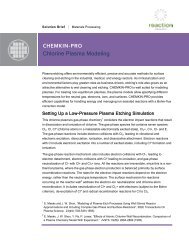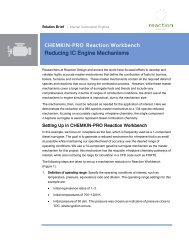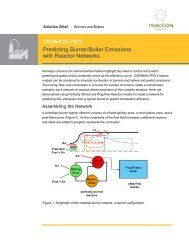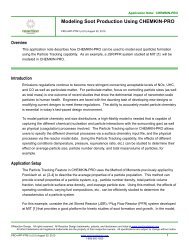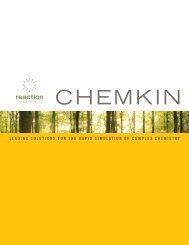Predicting Emissions from Burners and Boilers ... - Reaction Design
Predicting Emissions from Burners and Boilers ... - Reaction Design
Predicting Emissions from Burners and Boilers ... - Reaction Design
You also want an ePaper? Increase the reach of your titles
YUMPU automatically turns print PDFs into web optimized ePapers that Google loves.
Solution Brief | <strong>Burners</strong> <strong>and</strong> <strong>Boilers</strong>ENERGICO<strong>Predicting</strong> <strong>Emissions</strong> <strong>from</strong><strong>Burners</strong> <strong>and</strong> <strong>Boilers</strong> with ENERGICOFaster computers <strong>and</strong> better knowledge of fluid dynamics <strong>and</strong> combustion chemistry haveallowed CFD to become integrated into the combustor design process <strong>and</strong> to provide valuabledesign assistance. However, modern CFD codes provide limited chemistry information. Whiletoday’s computers are fast enough to h<strong>and</strong>le burner design models with several million cells,they are still not fast enough to incorporate all of the detailed combustion chemistry of the fuel.Consequently, applying detailed fuel chemistry in combustion simulation requires asimplification of the geometry.Representing the combustor with a series of idealized reactors allows use of detailed chemistrywith a reasonable amount of computational time. ENERGICO automatically converts a complexburner or boiler geometry into an Equivalent Reactor Network (ERN). Once the ERN is created,a fully detailed chemical mechanism can be used to provide an underst<strong>and</strong>ing of combustionperformance <strong>and</strong> emissions such as NO x , CO <strong>and</strong> Unburned Hydrocarbons (UHC).Setting Up in ENERGICOENERGICO reads in the reacting flow CFD solution of a natural gas-fired burner that is typicallyused in industrial or utility boilers (Figure 1). A series of filters are applied to the variables inthe CFD solution to divide the burner or boiler into regions that have similar conditions that areimportant for the desired results (e.g., temperature, oxygen concentration, fuel concentrationwhen looking at NO x emissions). A set of these filters comprises an ERN algorithm.ENERGICO can also automatically apply previously developed ERN algorithms to help savetime <strong>and</strong> eliminate errors.ENERGICO allows each reactor zone to be defined as either a Perfectly Stirred Reactor (PSR)with the temperature fixed to the average temperature in the CFD, a PSR with the energyequation turned on, or a Plug Flow Reactor (PFR). ENERGICO then creates the reactornetwork automatically <strong>and</strong> solves it using the detailed chemistry mechanism.
<strong>Predicting</strong> <strong>Emissions</strong> <strong>from</strong> <strong>Burners</strong> <strong>and</strong> <strong>Boilers</strong> with ENERGICOFigure 1. ENERGICO workflow starting <strong>from</strong> a CFD solution, dividing the combustor into Zonesthat become reactors in the ERNResultsResults for CO, NO, NO 2 <strong>and</strong> UHC emissions at the exit of the burner are presented in a table.They also can be plotted on top of the burner, boiler or furnace geometry. The high NO xconcentration occurs in the primary region of this lean-burn natural gas burner (Figure 2). AsENERGICO uses the full detailed mechanism, it is also possible to plot the NO x formation rate<strong>and</strong> discern if the NO x is thermal or non-thermal NO x .The CO emissions show high concentrations in the near burner region as expected <strong>from</strong> theprimary combustion of the fuel (Figure 3). It is helpful to plot the CO emissions at the exit of theburner or boiler to see where peaks of CO are located. The peak in CO concentration can thenbe traced back upstream to see if it is occurring because the flame is too long or quenchingalong the walls <strong>from</strong> cooling flows.REACTION DESIGN 2
<strong>Predicting</strong> <strong>Emissions</strong> <strong>from</strong> <strong>Burners</strong> <strong>and</strong> <strong>Boilers</strong> with ENERGICOFigure 2. NO emissions on the burner geometry.Figure 3. CO emissions on the burner geometry.©2013 <strong>Reaction</strong> <strong>Design</strong>. <strong>Reaction</strong> <strong>Design</strong> <strong>and</strong> CHEMKIN are registered trademarks of <strong>Reaction</strong> <strong>Design</strong>.FORTḖ, ENERGICO, CHEMKIN-PRO <strong>and</strong> CHEMKIN-PRO <strong>Reaction</strong> Workbench are trademarksof <strong>Reaction</strong> <strong>Design</strong>. All other trademarks are the property of their respective owners.REACTION DESIGN 3




